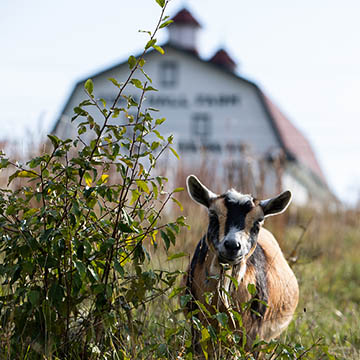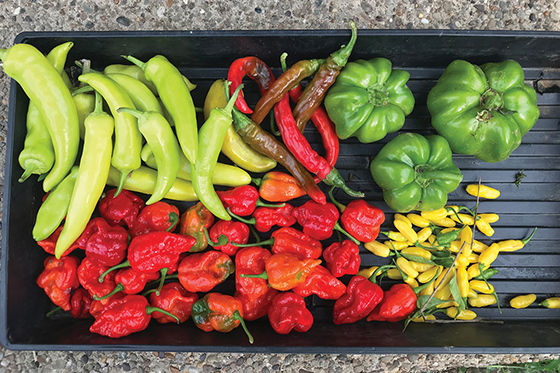Splendor in the Grass
Chatham’s Agroecology Demonstration Garden

What is it like to work in the garden?
“I would normally have run from the rain. And I have worked in the garden in the rain, and felt refreshed,” says Toni Simpson, MAFS ‘21.
Right near the Lodge at Eden Hall Campus, there’s a patch of land approximately two-thirds of an acre in size. This is the Agroecology Demonstration Garden (ADG).
Its mission is, well, let’s let Master of Arts in Food Studies student Liz Metzler, MAFS ’21, speak to it: “I’ve worked in so many gardens and never before had anyone be like ‘This is your garden; what do you want to do?’”
“The ADG is student-driven and student-determined,” explains assistant professor of agroecology Chris Murakami, who is the ADG faculty advisor. “We work to get students connected to projects here that resonate with them. Whether it’s gaining basic skills and knowledge; coming up with management systems or bigger plans; coordinating volunteers; or coordinating events or tours or workdays; the opportunities for learning are pretty broad. We try to figure out what kind of experiences they need in order to get them where they want to go.”
As the name states, the raison d’être of the ADG is to demonstrate principles of agroecology, but students and faculty are conducting research there too, asking questions like what are the impacts of transitioning to bio-intensive, regenerative market gardening practices, and how the garden can be designed to help enhance student motivation and self-determination.
Food from the ADG is shared among team members—Murakami has a “take what you need” policy—and the broader Chatham community through the dining halls. This past summer, the ADG was also able to donate produce to hunger relief efforts in Pittsburgh, and before COVID-19, the ADG team would gather for simple weekly community meals featuring food from the garden.
“We are so fortunate to have this abundance of space and natural resources [at Eden Hall Campus], and it’s a pretty big privilege, but along with that, we have the responsibility of how we develop the system and structure for students to use those resources as well as possible,” says Murakami. “It’s always going to be a work in progress, because it’s based on the needs and interests of students, but it’s something we try to lean into out here.”
What is agroecology?
“Agroecology is the science of sustainable, equitable food systems,” says Murakami. “It’s a set of practices that farmers and growers have created, and a social movement—a group of people globally who work for environmental justice and land access rights. Agroecology, as an entry point, is about empowering people.”
In the ADG, this looks like practices including recycling nutrients as much as possible, taking advantage of natural relationships in the production of food, and building healthy soil to mitigate the need for pesticides.
And true to the spirit of agroecology, it looks like less tangible things, too.
“It doesn’t matter if you are male or female, your age—you and your opinion matter here,” says Simpson. “We even discuss issues like Black Lives Matter. We talk about how we feel about them, and how working in the ADG assists us with dealing with these feelings. The ADG really encompasses the entire gamut of agroecology.”
What's growing in the garden?
Rittle Beans
Rittle beans are named after Chatham Associate Professor of nursing Chad Rittle, and the story goes like this: Rittle was observing a class Murakami was teaching, and mentioned afterward that he had some family heirloom beans that were brought over from Croatia. His family had been growing them and enjoying them as part of their holiday meals. He was down to his last jar, and no longer had a garden at his place, so he asked if they could grow some beans for him and his family.
“I loved that story,” says Murakami. “I love how much gets held in a plant or a seed, so we’ve been growing and saving those beans for the past couple of seasons, to make sure Chad has them at his family meals. Literally every crop that we have has some story behind it.”
Livestock
The student-driven livestock team—composed of 10-12 undergraduate and graduate students—manages three ducks, six chickens, and nine goats, which live at the bottom of the ADG. “We have a great partnership with the ADG,” says team member Eleanor Bacon, MAFS/MBA ‘20. “We use the chicken and the goats in vegetable plots. The chickens aerate the soil with their feet and eat bugs and rodents, and we use nutrients from the animals’ manure and urine to improve the health of the soil and help grow the vegetables’ root systems.”
“We have some problems with invasive species, but goats like them, and they can help knock some of that back,” adds Murakami.
Hot Peppers
“We were really into hot peppers for a while, and had this tradition of hot sauces,” says Murakami. “One of our students, Oliver (Pinder, Master of Arts in Food Studies ‘19) is from Trinidad and Tobago, and was able to get some Trinidad scorpion peppers—one of the hottest peppers in the world—and we were able to grow them here. Food can be transcendent, a taste from home. So we try to do what we can to offer that to our students. And then also, we want people to make meaning in this space, so there are hopefully tastes that bring them back, later in life, here, to their time working in the garden.”

Three Sisters
Growing the “three sisters”—corn, beans, and squash—together is part of a tradition in Mexico, meso-America, and southern portions of what’s now the U.S., where they were considered sacred crops, explains Murakami, noting that looking to indigenous production practices is a principle of agroecology. “These crops grow together in a mutually beneficial way: The corn provides the pole for the beans to grow up. Beans deposit nitrogen from the air into the soil, in a form that the plants can use. The leaves from the squash spread out, suppressing weeds and keeping the soil moist. The squash are also spiny, which can help keep raccoons away from the corn.”
Lemongrass, Galangal, Thai Basil
“The agroecology garden used to be a global cuisine garden,” says Murakami, “and planting produce from Southeast Asia shows us what it takes to grow something in a non-native environment, and understand the great lengths to which people might go to preserve their ability to have certain foods.”
Culinary and Medicinal Herb Garden
Toni Simpson, M.A. Food Studies ’21 is a professional chef originally from Barbados. As part of her experience in Murakami’s basic agroecology course, she cultivated a medicinal and culinary herb garden in the ADG, and developed a lavender facial scrub, a calendula salve (good for eczema, anti-inflammatory and anti-bacterial), and a comfrey salve (good for arthritic pain).
Simpson sees other uses for the herbs, too. “In Barbados, it’s very much a tradition to drink what we call ‘cooling teas’ when we’re ill. For example, you would drink a ginger tea to settle an upset stomach, or a lemon and thyme tea to get rid of a cold,” she says, noting that the knowledge required to formulate these teas tends to be passed from generation to generation.
“Bio-intensive” refers to achieving maximum yields from a minimum area of land, while increasing biodiversity and sustaining the fertility of the soil.
